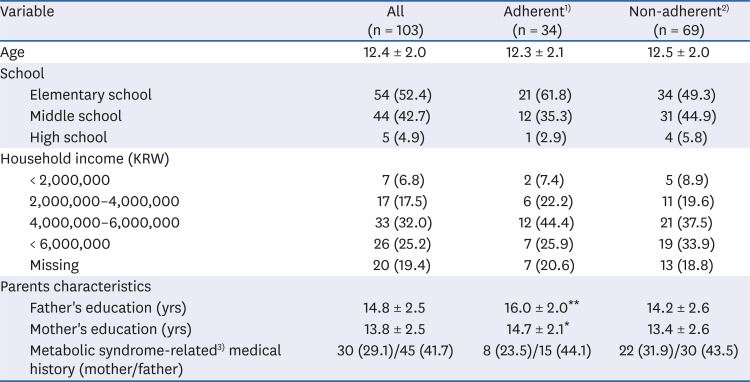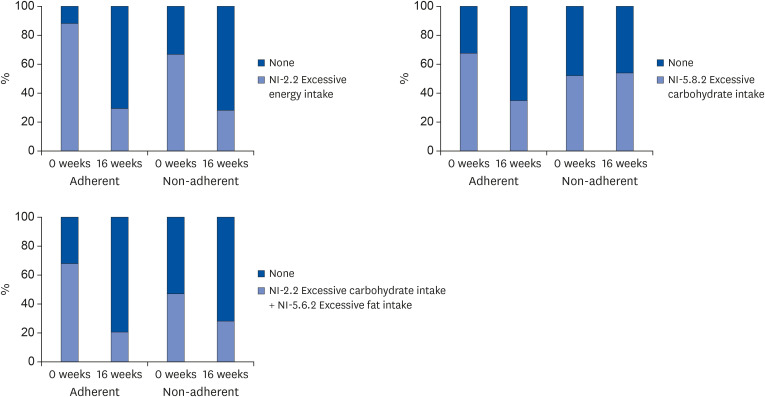1. World Health Organization. Report of the Commission on Ending Childhood Obesity. Geneva: World Health Organization;2016.
2. Korea Centers for Disease Control and Prevention. 2015 Korea Health Statistics. Cheongju: Korea Centers for Disease Control and Prevention;2017.
3. Burke V, Beilin LJ, Simmer K, Oddy WH, Blake KV, Doherty D, Kendall GE, Newnham JP, Landau LI, Stanley FJ. Predictors of body mass index and associations with cardiovascular risk factors in Australian children: a prospective cohort study. Int J Obes. 2005; 29:15–23.

4. Calcaterra V, Klersy C, Muratori T, Telli S, Caramagna C, Scaglia F, Cisternino M, Larizza D. Prevalence of metabolic syndrome (MS) in children and adolescents with varying degrees of obesity. Clin Endocrinol (Oxf). 2008; 68:868–872. PMID:
17980007.

5. Kelly AS, Barlow SE, Rao G, Inge TH, Hayman LL, Steinberger J, Urbina EM, Ewing LJ, Daniels SR. American Heart Association Atherosclerosis, Hypertension, and Obesity in the Young Committee of the Council on Cardiovascular Disease in the Young, Council on Nutrition, Physical Activity and Metabolism, and Council on Clinical Cardiology. Severe obesity in children and adolescents: identification, associated health risks, and treatment approaches: a scientific statement from the American Heart Association. Circulation. 2013; 128:1689–1712. PMID:
24016455.
6. Smith KJ, Gall SL, McNaughton SA, Blizzard L, Dwyer T, Venn AJ. Skipping breakfast: longitudinal associations with cardiometabolic risk factors in the Childhood Determinants of Adult Health Study. Am J Clin Nutr. 2010; 92:1316–1325. PMID:
20926520.

8. Lacey K, Pritchett E. Nutrition Care Process and Model: ADA adopts road map to quality care and outcomes management. J Am Diet Assoc. 2003; 103:1061–1072. PMID:
12891159.

9. Vivanti A, Ferguson M, Porter J, O'sullivan T, Hulcombe J. Increased familiarity, knowledge and confidence with Nutrition Care Process Terminology following implementation across a statewide health-care system. Nutr Diet. 2015; 72:222–231.

10. Thompson KL, Davidson P, Swan WI, Hand RK, Rising C, Dunn AV, Lewis N, Murphy WJ. Nutrition care process chains: the “missing link” between research and evidence-based practice. J Acad Nutr Diet. 2015; 115:1491–1498. PMID:
26072420.

11. Swan WI, Vivanti A, Hakel-Smith NA, Hotson B, Orrevall Y, Trostler N, Beck Howarter K, Papoutsakis C. Nutrition Care Process and Model update: toward realizing people-centered care and outcomes management. J Acad Nutr Diet. 2017; 117:2003–2014. PMID:
28988837.

12. World Health Organization. People-centred Care in Low- and Middle-Income Countries. Geneva: World Health Organization;2010.
13. Bay JL, Morton SM, Vickers MH. Realizing the potential of adolescence to prevent transgenerational conditioning of noncommunicable disease risk: multi-sectoral design frameworks. Healthcare (Basel). 2016; 4:39.

14. Md Yusop NB, Mohd Shariff Z, Hwu TT, Abd Talib R, Spurrier N. The effectiveness of a stage-based lifestyle modification intervention for obese children. BMC Public Health. 2018; 18:299. PMID:
29490648.

15. Ribeiro RQ, Alves L. Comparison of two school-based programmes for health behaviour change: the Belo Horizonte Heart Study randomized trial. Public Health Nutr. 2014; 17:1195–1204. PMID:
23438441.

16. Novotny R, Nigg CR, Li F, Wilkens LR. Pacific kids DASH for health (PacDASH) randomized, controlled trial with DASH eating plan plus physical activity improves fruit and vegetable intake and diastolic blood pressure in children. Child Obes. 2015; 11:177–186. PMID:
25671796.

17. Lee JE, Lee DE, Kim K, Shim JE, Sung E, Kang JH, Hwang JY. Development of tailored nutrition information messages based on the transtheoretical model for smartphone application of an obesity prevention and management program for elementary-school students. Nutr Res Pract. 2017; 11:247–256. PMID:
28584582.

18. Berkowitz RI, Marcus MD, Anderson BJ, Delahanty L, Grover N, Kriska A, Laffel L, Syme A, Venditti E, Van Buren DJ, Wilfley DE, Yasuda P, Hirst K. TODAY Study Group. Adherence to a lifestyle program for youth with type 2 diabetes and its association with treatment outcome in the TODAY clinical trial. Pediatr Diabetes. 2018; 19:191–198. PMID:
28664624.

19. Kalarchian MA, Levine MD, Arslanian SA, Ewing LJ, Houck PR, Cheng Y, Ringham RM, Sheets CA, Marcus MD. Family-based treatment of severe pediatric obesity: randomized, controlled trial. Pediatrics. 2009; 124:1060–1068. PMID:
19786444.

20. De Miguel-Etayo P, Moreno LA, Santabárbara J, Martín-Matillas M, Piqueras MJ, Rocha-Silva D, Marti Del Moral A, Campoy C, Marcos A, Garagorri JM. EVASYON Study Group. Anthropometric indices to assess body-fat changes during a multidisciplinary obesity treatment in adolescents: EVASYON Study. Clin Nutr. 2015; 34:523–528. PMID:
24993080.

21. Gow ML, Ho M, Burrows TL, Baur LA, Stewart L, Hutchesson MJ, Cowell CT, Collins CE, Garnett SP. Impact of dietary macronutrient distribution on BMI and cardiometabolic outcomes in overweight and obese children and adolescents: a systematic review. Nutr Rev. 2014; 72:453–470. PMID:
24920422.

22. Korea Centers for Disease Control and Prevention. 2017 Korea Growth Charts. Seoul: Korean Pediatrics Society;2017.
23. Korean Nutrition Society. Dietary Reference Intakes for Koreans. Seoul: Korean Nutrition Society;2015.
24. Writing Group of the Nutrition Care Process/Standardized Language Committee. Nutrition care process and model part I: the 2008 update. J Am Diet Assoc. 2008; 108:1113–1117. PMID:
18589014.
25. Dietz WH, Baur LA, Hall K, Puhl RM, Taveras EM, Uauy R, Kopelman P. Management of obesity: improvement of health-care training and systems for prevention and care. Lancet. 2015; 385:2521–2533. PMID:
25703112.

26. Manios Y, Grammatikaki E, Papoutsou S, Liarigkovinos T, Kondaki K, Moschonis G. Nutrient intakes of toddlers and preschoolers in Greece: the GENESIS study. J Am Diet Assoc. 2008; 108:357–361. PMID:
18237582.

27. Halberstadt J, de Vet E, Nederkoorn C, Jansen A, van Weelden OH, Eekhout I, Heymans MW, Seidell JC. The association of self-regulation with weight loss maintenance after an intensive combined lifestyle intervention for children and adolescents with severe obesity. BMC Obes. 2017; 4:13. PMID:
28451439.

28. Whitlock EP, O'Connor EA, Williams SB, Beil TL, Lutz KW. Effectiveness of weight management interventions in children: a targeted systematic review for the USPSTF. Pediatrics. 2010; 125:e396–418. PMID:
20083531.

29. US Preventive Services Task Force. Barton M. Screening for obesity in children and adolescents: US Preventive Services Task Force recommendation statement. Pediatrics. 2010; 125:361–367. PMID:
20083515.









 PDF
PDF Citation
Citation Print
Print






 XML Download
XML Download